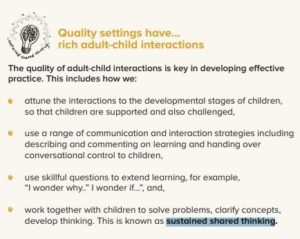Sustained, Shared, Thinking (SST)
Many theorists believe, and research shows that sustained shared thinking is fundamental to how practitioners approach children’s learning and development:
“‘Sustained shared thinking’ occurs when two or more individuals’ work together’ in an intellectual way to solve a problem, clarify a concept, evaluate an activity, extend a narrative etc. Both parties must contribute to the thinking and it must develop and extend the understanding. It was more likely to occur when children were interacting 1:1 with an adult or with a single peer partner and during focussed group work.”
(The Effective Provision of Pre-School Education, Sylva et al., 2004, p. 6)
Kathy Brodie is an Early Years Professional, consultant and trainer based in East Cheshire, UK.
See below for Kathy Brodie’s ten simple techniques for improving sustained, shared thinking.
- Really taking an interest: Making time to listen and talk to children, ideally individually, recalling previous conversations and encouraging and expanding the conversation. This improves SST through sharing ideas and extending conversations; this is the ‘sustained part’ of SST.
- Tuning into children’s interests: Understanding the children’s fascinations, knowing the context of the child, their background, their family and community. This technique improves SST because using this knowledge to ask questions can help to expand thinking.
- Range of experiences: A more comprehensive range of experiences ensures more to talk about and explore together. Reminding children of previous experiences improves SST because it widens the field of experiences to talk about and extends thinking.
- Active Listening: Active listening is: Having positive, open body language; Being down at child’s level; and, making eye contact (if appropriate). Kathy says that the minute you put your head down to write, you lose that connection that can kill a conversation. With active listening, respecting and valuing what the child is saying, not making off the cuff comments and moving on to something else. Try not to self-listen; it is very common to think about where this interaction might be going and what you can do with it. Try just being in the moment with the child and ignoring internal thought processes for a little while. Active listening improves SST because through genuinely listening and concentrating on the conversation, an authentic shared experience is created.
- Positive Questioning: Questioning should not be an interrogation; questioning should be peppered with other techniques such as pondering aloud, using question starters like “I wonder if…”. A running narrative technique, where the adult comments on what the child is doing without pressure, is suitable for shy children or children with English as an additional language. Knowing the language development of all the children and switching thinking to focus on the needs of different children. Creating an atmosphere that encourages children to ask questions is essential. This technique of Positive Questioning improves SST because it gathers additional information to expand thinking in a supportive and caring way.
- Problem-solving – working together: Working together means talking with the child, not at them. It is a combination of supporting, scaffolding (but not presenting solutions too soon), and engaging in joint problem-solving, which is a life-long skill. Working together means valuing process over product and improving SST; discussing a common problem together can be a rich source of conversation, increasing the ‘sustained’ part of SST.
- Encourage metacognition: Metacognition is “thinking about thinking”, “knowing about knowing”, and encouraging children is supporting them to understand their own thinking processes. It is a lifelong skill and can allow children to become more self-aware and boost self-esteem. Practitioners must also remember that what a child is DOING doesn’t always reflect what they are THINKING about; it is what a child is THINKING about that they will REMEMBER. Therefore, practitioners must get into the children’s headspace and join their thinking. Encouraging metacognition improves SST by increasing children’s thinking skills.
- Try to learn something yourself: As practitioners work with children, they are always learning. Learning from the interactions, whether that is information about the children’s interests, prior knowledge, experiences, or level of development. Learning something ourselves improves SST and self-reflection because this information can be used to plan relevant activities, next steps, and experiences for the children.
- Observe, Wait and Listen: This is similar to the “Wait, Watch, Wonder” concept. Silence is your friend; wait, watch and wonder before deciding how to interact (if at all). Observations can inform conversations with the children. Ensuring this improves SST because the knowledge gathered from observation can start a conversation and pre-empt some of the children’s thinking processes.
- Don’t assume: Do not assume or jump in with the educational answer; by waiting, watching and wondering without jumping in, really listening to the children and thinking about their needs is possible.
Further information can be found in the following articles and books: (Conceptualising progression in the pedagogy of play and sustained shared thinking in early childhood education: a Vygotskian perspective, Siraj-Blatchford, 2009)


